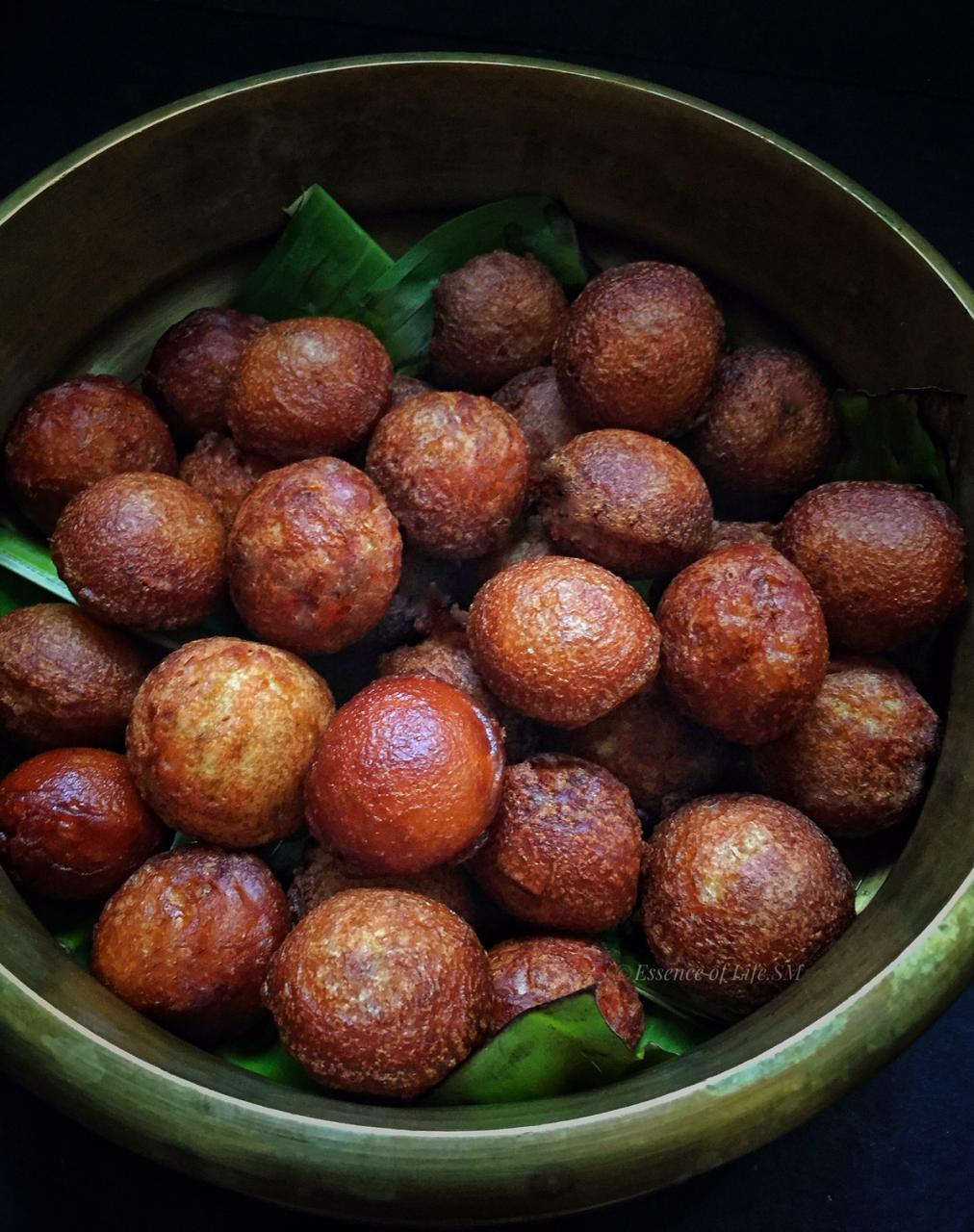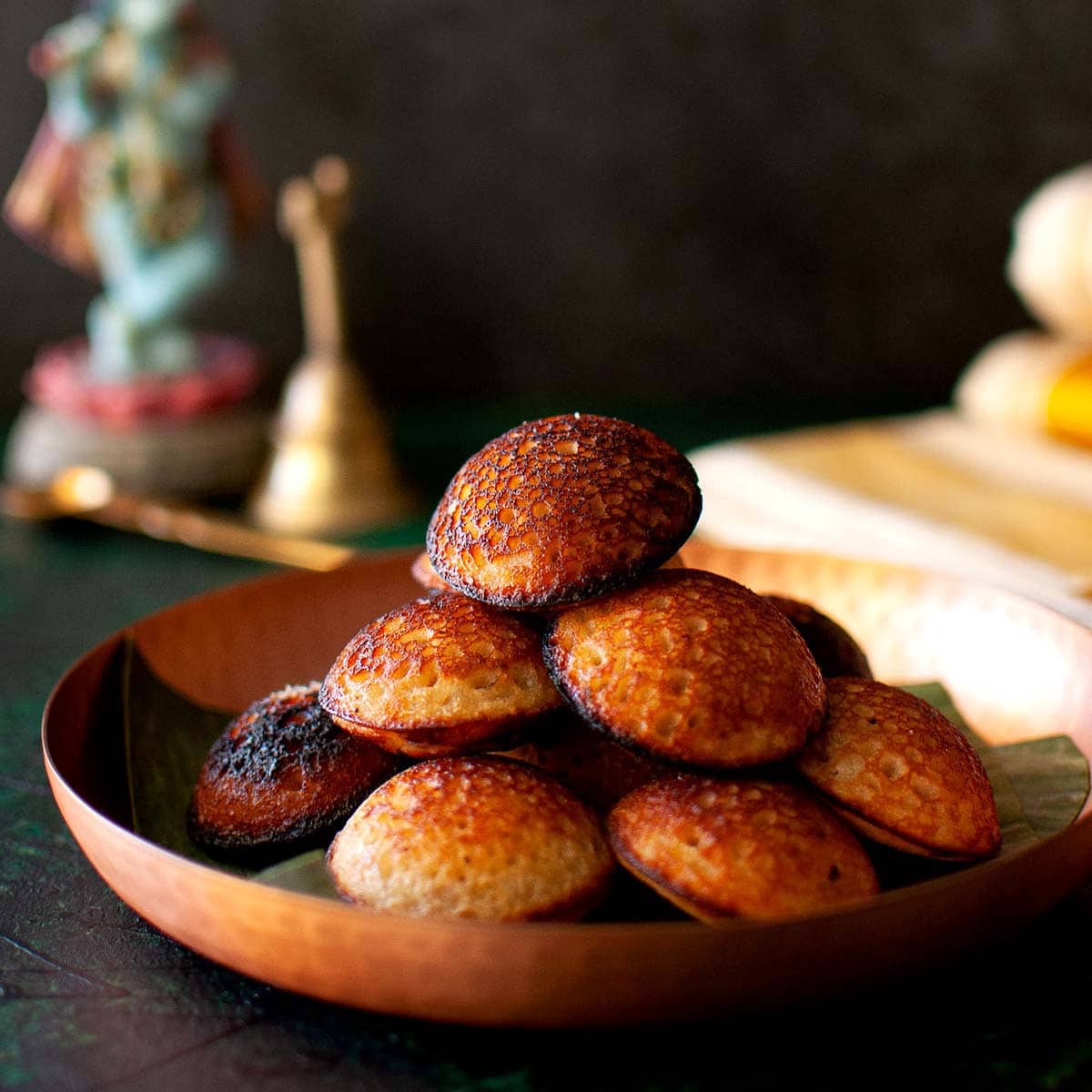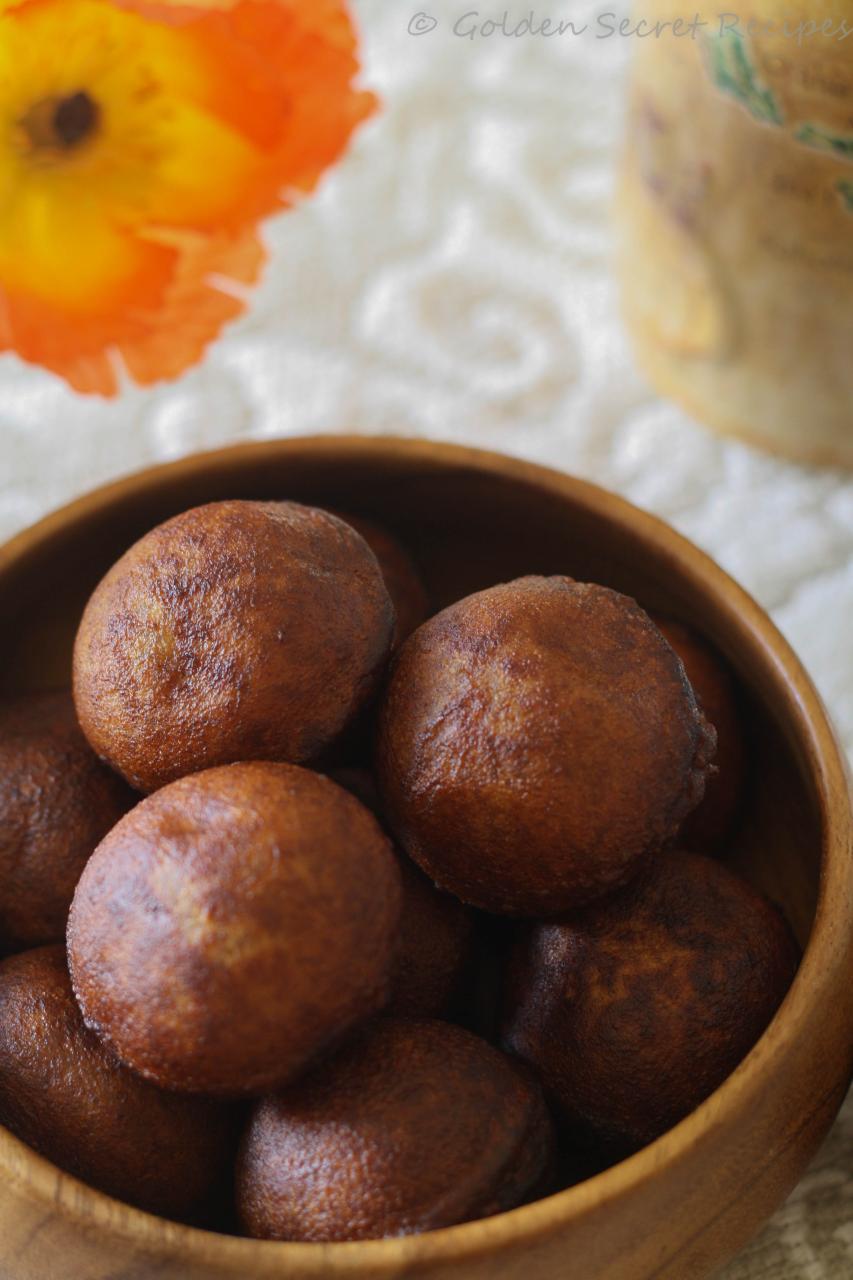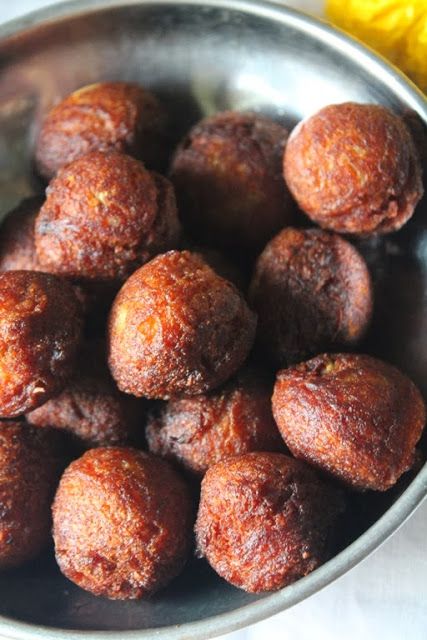Unni Appam, also known as Unniyappam, is a traditional snack hailing from the southern states of India, particularly Kerala. This quintessential dish is deeply rooted in Kerala’s culinary traditions and serves as a beloved treat during festivals, religious ceremonies, and special occasions.
The name “Unni Appam” translates to ‘small rice cake’ in Malayalam, where ‘Unni’ means small and ‘Appam’ stands for cake or pancake. These bite-sized delights are made from a fermented batter comprising rice flour, jaggery (a type of unrefined sugar), mashed bananas, and a variety of spices like cardamom and ghee (clarified butter). The incorporation of coconut pieces fried in ghee adds a crunch that contrasts wonderfully with the soft, fluffy texture of the appam.
Unni Appam is traditionally cooked in an ‘Appakara’ – a special moulded pan with several hemispherical indentations, which gives them their distinctive dome shape. The batter is poured into these moulds and fried until they turn a deep golden brown, resulting in a crispy outer layer that encases a soft, sweet interior.
Unni Appam Recipe


Unni Appam
Equipment
- 1 saucepan
- 1 medium bowl
Ingredients
- 1/2 cup water
- 1 cup powdered jaggery
- 1/4 cup all-purpose flour
- 1/4 cup rice flour
- 1/4 cup whole-wheat flour
- 1/8 teaspoon salt
- 1/8 teaspoon baking soda
- 1/2 teaspoon ground cardamom
- 2 teaspoons sesame seeds toasted
- 2 tablespoons shredded fresh coconut or frozen, thawed to room temperature
- 1 banana puréed
- 1/2 cup vegetable or corn oil
- Melted ghee for drizzling
Instructions
- In a saucepan over medium heat, bring the water and jaggery to a simmer. When the jaggery melts, turn off the heat. Strain the jaggery water through a fine-mesh strainer set over a bowl to remove any impurities.
- In a medium bowl, whisk the all-purpose flour, rice flour, whole-wheat flour, salt, baking soda, cardamom, sesame seeds, and coconut.
- Whisk in the puréed banana.
- While whisking, slowly pour in the jaggery water, until it forms a smooth, pourable, lump-free batter. Let the batter rest for 15 minutes.
- Line a plate with paper towels and set aside.
- Place an appe or paniyaram pan over medium-high heat until hot.
- Reduce the heat to medium and add 1 teaspoon of oil to each mold. Fill each mold three-quarters full with batter. Cook for 1 to 11⁄2 minutes. Using a knife or fork, carefully flip the appams. Cook for 45 seconds to 1 minute more. Remove them from the pan and place on the paper towel–lined plate. Repeat with the remaining appams.
- Drizzle the finished appams with melted ghee, about 1⁄4 teaspoon each, and serve hot.
Notes
Cooking Tips about Unni Appam

- Choosing the Right Rice: Use good quality raw rice for making the batter. The rice needs to be soaked for a few hours (typically 4-5 hours) before grinding. Some prefer using parboiled rice (Puzhukkalari) as it provides a slightly different texture.
- Jaggery Consistency: Melting and straining the jaggery is crucial to remove any impurities. The consistency of the jaggery syrup should be such that it’s neither too thick nor too thin, as it forms the base of the sweet flavor in the appams.
- Frying Coconut Bits: Fry the small coconut pieces in ghee until they turn golden brown. This not only enhances their flavor but also adds a crunchy texture to the otherwise soft appams.
- Fermenting the Batter: Allow the batter to ferment for a few hours. Fermentation gives a slight tanginess and contributes to the fluffiness of the Unni Appam. However, unlike some other fermented dishes, a shorter fermenting time is preferable for Unni Appam.
- Balancing Batter Consistency: The batter’s consistency is key; it should be thick enough to hold shape but fluid enough to pour easily into the moulds. Adjust the batter with water or additional rice flour to achieve the desired consistency.
- Correct Cooking Temperature: Heat the appam pan (appakara) properly before pouring in the batter. Each mould should be greased with ghee which adds flavor and ensures the Unni Appams are easily released once cooked. If the pan isn’t hot enough, the appams may stick or not form well.
- Adding Banana: Mashed ripe bananas added to the batter offer sweetness, moisture, and a delightful aroma. Ensuring the bananas are well mashed and smoothly incorporated into the batter ensures uniformity in flavor.
- Pan Rotation for Even Cooking: After pouring the batter into the moulds, gently rotate the pan during the cooking process to ensure the top of the appam cooks evenly with the steam prior to flipping.
- Patience in Flipping: Wait until the edges start to turn golden brown and slightly pull away from the mould before flipping each appam. They should be crisp on the outside and soft on the inside.
- Serving Suggestions: Though delicious on their own, Unni Appams can be served with a side of coconut milk or a sprinkle of cardamom sugar for an extra flavor boost.
Serving suggestions about Unni Appam

- As a Festive Treat: Unni Appam is an integral part of celebrations and religious ceremonies in Kerala. Serve it as a special treat during festivals like Onam or Vishu, or as ‘Prasadam’ in temples.
- With Tea or Coffee: The sweet flavor and soft texture of Unni Appam make it an excellent accompaniment to tea or coffee. Its subtle sweetness pairs wonderfully with the bitterness of these beverages, making it a perfect snack for tea time.
- As a Dessert: While Unni Appam is traditionally not a dessert, its sweet and rich flavor allows it to double as one. Serve it with a sprinkle of sugar or a drizzle of honey on top for an extra sweet touch. Pairing it with a scoop of vanilla or coconut ice cream can also create a delightful fusion dessert.
- With Banana Stew: In Kerala, a sweet banana stew made with ripe bananas, jaggery, and coconut milk, known as Pazham Pori, can be served alongside Unni Appam for a truly decadent treat.
- Presentation: Given its attractive dome shape and golden-brown color, Unni Appam can be creatively presented on a platter, garnished with slices of banana and a few leaves of mint for a refreshing contrast. This makes it visually appealing and inviting, adding to the overall dining experience.
Top 5 FAQs about Unni Appam

- What is Unni Appam? Unni Appam, often referred to as Unniyappam, is a popular traditional snack originating from Kerala, India. It’s a sweet, small rice cake made from a fermented batter consisting of rice flour, jaggery, mashed bananas, and spices like cardamom, all fried in ghee-clarified butter. Unni Appam is known for its soft and fluffy interior with a crispy golden exterior, often including chunks of coconut fried in ghee for added texture.
- What does the name ‘Unni Appam’ signify? The name ‘Unni Appam’ translates to ‘small rice cake’ in Malayalam, the local language of Kerala. “Unni” means small or little, and “Appam” refers to a cake or pancake, aptly describing these bite-sized snacks.
- How is Unni Appam traditionally made? Traditionally, Unni Appam is made by combining soaked raw rice or rice flour, melted jaggery, mashed ripe bananas, and finely chopped or ground coconut pieces into a batter. This batter is seasoned with cardamom and deep-fried in an ‘Appakara,’ a special moulded pan with hemispherical indentations, until it turns golden brown. The result is a delicious snack with a crispy outside and a soft, fluffy inside.
- What is the significance of Unni Appam in Kerala culture? Unni Appam holds profound cultural significance in Kerala, where it’s deeply embedded in the culinary traditions. It is commonly prepared for festivals, religious ceremonies, and special occasions. Unni Appam is often offered as ‘Prasadam’ (a devotional offering made to gods) in Hindu temples across Kerala and shared among friends and family as a symbol of love and good fortune.
- Are there variations in the recipe for Unni Appam? Yes, while the basic ingredients remain consistent—rice flour, jaggery, mashed bananas, and spices—some variations may include different types of bananas for distinct flavors or additional ingredients like sesame seeds. Additionally, some may opt for parboiled rice instead of raw rice for a slight variation in texture. The methods of preparation and accompanying side dishes can also vary from region to region within Kerala.
Unni Appam stands as a true gem in the realm of traditional Indian snacks, especially within the rich culinary tapestry of Kerala. This delightful snack, with its soft, fluffy interior and crispy golden exterior, embodies the essence of Kerala’s festive and culinary spirit. Its preparation involves a harmonious blend of rice flour, jaggery, mashed bananas, and a touch of cardamom, all coming together to create a snack that is not only flavorful but also evokes nostalgia and warmth with each bite.

Leave a Reply